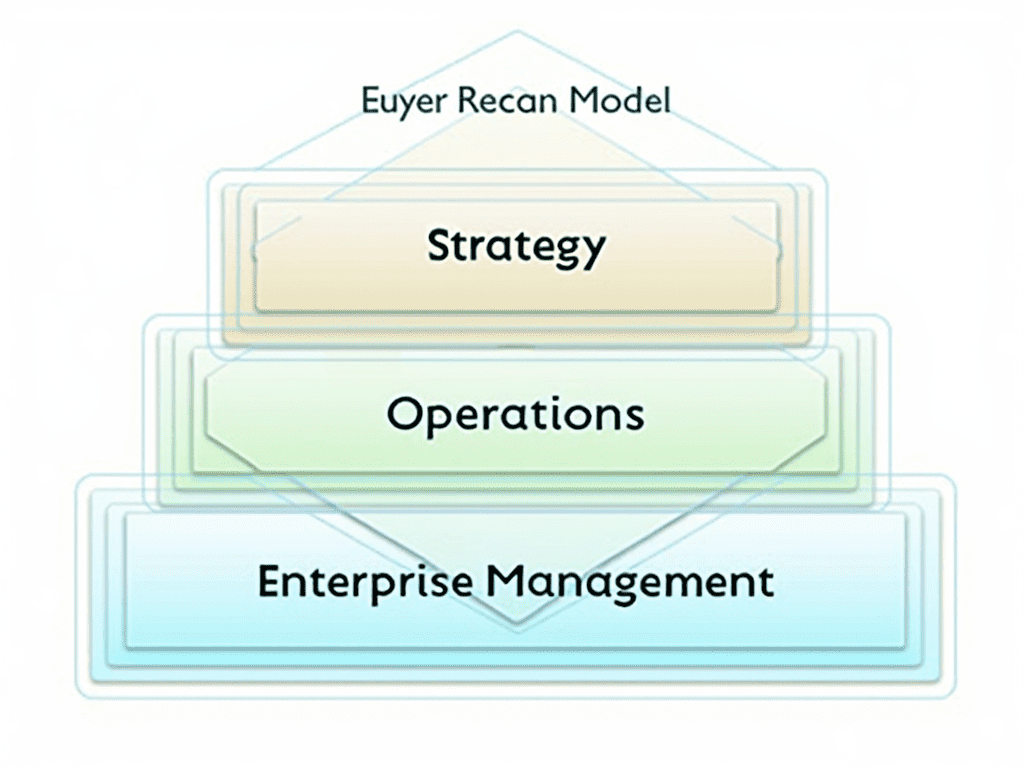
The Enhanced Telecom Operations Map (eTOM)
The Enhanced Telecom Operations Map (eTOM) process model, developed by TM Forum, offers a comprehensive framework that transforms telecommunications business process management. This structured approach organizes and enhances operational processes through a multi-layered, hierarchical classification system. Telecom organizations can create standardized process flows that connect high-level strategic planning with detailed operational tasks, fundamentally changing how telecommunications companies organize and refine their operations.
Key Takeaways:
- The eTOM process model provides a standardized framework for telecommunications organizations to map, analyze, and improve their business processes.
- It covers three primary process areas: Strategy, Infrastructure & Product (SIP), Operations, and Enterprise Management.
- The framework facilitates cross-departmental collaboration and creates a common language for process communication.
- Organizations implementing eTOM can reduce operational complexity and minimize implementation risks.
- The model enables continuous improvement and supports digital transformation initiatives in telecommunications and beyond.
The TM Forum’s eTOM model serves as the backbone for operational excellence in the telecommunications industry. This standardized approach helps companies streamline their processes while maintaining a competitive advantage in a rapidly changing market.
Telecom service providers face increasing pressure to deliver exceptional customer experiences while optimizing their operational efficiency. The structured nature of eTOM helps identify process gaps and overlaps, creating opportunities for significant improvements across the organization.
The implementation of eTOM delivers tangible benefits including reduced costs, improved service quality, and faster time-to-market for new products. Many leading telecommunications companies have adopted this framework to gain better visibility into their end-to-end operations and enhance decision-making capabilities at all levels.
For technical teams, eTOM provides clear process definitions that align with industry best practices. This standardization simplifies system integration and automation efforts while supporting compliance with regulatory requirements.
The adaptable framework allows for customization based on specific organizational needs without losing the core benefits of the model. You’ll find this flexibility particularly valuable during digital transformation initiatives where telecom process optimization plays a critical role in success.
“The eTOM process model empowers telecommunications organizations to streamline and enhance their operations through a standardized framework that fosters collaboration and clarity. By transforming complex processes into structured, actionable workflows, eTOM not only facilitates strategic alignment but also drives continuous improvement and digital innovation across the industry.”
Origins and Evolution
The Enhanced Telecom Operations Map (eTOM process model) stands as a cornerstone framework in telecommunications business process management. Developed by TM Forum, a global association representing over 700 service providers and suppliers across 75 countries, this comprehensive model has transformed how telecom companies structure their operations.
The eTOM process model began its journey as the Telecom Operations Map (TOM) in 2001. As industry needs evolved, it developed into the Enhanced Telecom Operations Map and was later rebranded as the Business Process Framework in 2009. Currently at version 24.5.0, the framework continues to adapt to shifting industry demands while maintaining its core functionality.
Framework Development Milestones
The eTOM process model has undergone several significant transformations since its inception:
- Initial launch as TOM in 2001 focusing on basic telecom operations
- Evolution to eTOM with expanded scope covering end-to-end business processes
- Rebranding as Business Process Framework while maintaining the eTOM process model principles
- Continuous updates to incorporate emerging technologies and business practices
- Integration with complementary frameworks to create a comprehensive operations toolkit
The eTOM process model’s multi-layered, hierarchical approach to business process classification provides telecom organizations with a structured way to examine and improve their operations. This architecture includes three primary process areas: Strategy, Infrastructure & Product (SIP), Operations, and Enterprise Management, creating a common language that facilitates effective project collaboration across organizational boundaries.
What makes the eTOM process model particularly valuable is its ability to create standardized process flows from high-level strategic planning down to detailed operational tasks. You’ll find this framework spans the entire value chain from marketing and product development through to service delivery and ongoing operations.
When implementing the eTOM process model, you should begin with a thorough process mapping and gap analysis. This helps identify opportunities for continuous improvement while ensuring alignment with industry standards. The TM Forum offers various resources including fundamentals training, practitioner courses, and conformance certification to support your implementation journey.
By adopting the eTOM process model, your organization can reduce operational complexity, minimize implementation risks, streamline system integration, and significantly improve operational efficiency across all telecommunications functions.
The enhanced telecom operations map (eTOM) is more than just a framework; it’s a catalyst for transforming operational efficiency in telecommunications, enabling companies to adapt swiftly to market changes and technology advancements.
forbes.com
Framework Structure and Components
The eTOM process model delivers a multi-layered, hierarchical classification of business processes specifically designed for telecommunications companies. You’ll find this framework organizes operations into three primary process areas that cover all aspects of a telecom business.
Primary Process Areas
The eTOM process model structures operations into these key areas:
- Strategy, Infrastructure & Product (SIP): Encompasses processes for developing strategy, planning infrastructure, and managing product lifecycles. This area focuses on the etom process model elements that drive long-term business planning and product development.
- Operations: Covers day-to-day operational activities including customer relationship management, service management, resource management, and supplier/partner relationship management. The etom process model shines here by providing detailed workflows for service delivery and maintenance.
- Enterprise Management: Addresses corporate functions like human resources, financial management, and stakeholder relationship management that support the etom process model implementation across the organization.
Each of these areas in the etom process model breaks down into increasingly detailed process elements. This hierarchical approach allows you to implement strategic planning at various levels of granularity depending on your needs.
The framework provides end-to-end process flows that connect high-level strategic activities to detailed operational tasks. You can map existing processes against the etom process model to identify gaps and optimization opportunities in your telecom operations.
One of the most valuable aspects of the etom process model is how it facilitates project collaboration across departments. The following table illustrates how the etom process model bridges functional silos:
| Process Area | Key Components | Primary Beneficiaries |
|---|---|---|
| SIP | Product Strategy, Infrastructure Planning | Product Teams, Network Engineers |
| Operations | Service Fulfillment, Assurance | Customer Support, Network Operations |
| Enterprise Management | Finance, HR, Risk Management | Executive Leadership, Support Functions |
The etom process model creates a common language for communication about business processes, making it easier to align various stakeholders. By implementing this framework, you’ll enable comprehensive mapping and analysis of organizational processes while improving stakeholder satisfaction.
Using the etom process model helps you reduce operational complexity and streamline system integration across your telecommunications business. The framework’s modular structure allows for incremental implementation, helping you manage change while maintaining operational continuity through proper project integration management.
Expert Insight: When utilizing the eTOM process model for telecommunications, focus on thoroughly understanding its three primary process areas: Strategy, Infrastructure & Product (SIP), Operations, and Enterprise Management. This hierarchical framework not only facilitates detailed process mapping but also fosters collaboration across departments by providing a common language for business processes. By aligning your operational tasks with high-level strategic objectives, you’ll uncover optimization opportunities and enhance stakeholder satisfaction significantly.
Purpose and Strategic Benefits
The eTOM process model creates a common language for business process communication across telecommunications organizations. This framework helps you clearly articulate and standardize operational procedures, eliminating confusion when different departments discuss processes. The eTOM process model serves as a universal translator, ensuring everyone understands process requirements regardless of their technical background.
You’ll find the eTOM process model particularly valuable for facilitating collaboration across departments, partners, and systems. By providing standardized process definitions, it breaks down silos between traditionally separate functions like marketing, network operations, and customer service. When implementing cross-functional initiatives, the eTOM process model provides clear visibility into how changes affect each area of your organization.
The eTOM process model covers your entire value chain from marketing and product development to service delivery and operations. This comprehensive approach ensures you can:
- Reduce operational complexity by eliminating redundant processes
- Minimize implementation risks through standardized approaches
- Streamline system integration with clear interface definitions
- Improve operational efficiency by identifying optimization opportunities
Key Strategic Advantages
The eTOM process model delivers several critical advantages for telecommunications organizations:
- Risk Reduction: Standardized processes help you avoid common pitfalls in project implementation phases, reducing the likelihood of costly errors.
- Enhanced Efficiency: By mapping current processes to the eTOM framework, you can identify gaps and opportunities for automation or elimination of unnecessary steps.
- Improved Integration: The model facilitates better system integration by providing clear definitions of interfaces between different business processes.
- Better Decision-Making: A comprehensive process view enables more informed go/no-go decisions regarding technology investments.
- Accelerated Transformation: The framework provides a roadmap for digital transformation initiatives, helping you prioritize process improvements.
The strategic value of the eTOM process model extends beyond operational improvements. By adopting this framework, you gain access to industry best practices from over 700 member companies across 75 countries. This collective knowledge helps you avoid reinventing processes that others have already optimized. The eTOM process model also enables benchmarking against industry standards, helping you identify areas where your processes may lag behind competitors.
For telecommunications providers facing increasing competition and margin pressure, the eTOM process model provides a structured approach to operational excellence. The model’s comprehensive nature ensures you don’t miss critical process areas when planning improvements. This holistic perspective is particularly valuable when implementing major organizational changes or new service offerings.
Industry Applications and Adoption
The eTOM process model has expanded far beyond its initial telecommunications focus. You’ll find this framework applied across various industries due to its comprehensive approach to operational management. The eTOM process model creates standardized business processes that enable more efficient operations, breaking down departmental silos and establishing clear communication channels.
In telecommunications, major providers have implemented the eTOM process model to streamline customer service operations. This has resulted in improved response times and customer satisfaction metrics. According to TM Forum data, companies that fully adopt the eTOM process model report 15-20% operational efficiency improvements within the first year of implementation.
Beyond telecom, the eTOM process model has found applications in:
- Digital service providers leveraging the framework for service orchestration
- Banking institutions adopting process flows for customer management
- Healthcare organizations implementing the model for service delivery optimization
- Utility companies using the eTOM process model for infrastructure management
Implementation Success Factors
When implementing the eTOM process model in your organization, several factors determine success. Effective project implementation requires careful planning and execution. Companies that successfully adopt the eTOM process model typically follow these guidelines:
- Start with executive sponsorship and clear objectives
- Map current processes before attempting transformation
- Focus on high-impact areas for initial implementation
- Train staff thoroughly on new processes
- Use incremental deployment rather than big-bang approaches
The integration capabilities of the eTOM process model make it particularly valuable for organizations undergoing digital transformation. By providing a continuous improvement framework, companies can progressively enhance their operations while maintaining service continuity.
| Industry | Adoption Level | Primary Applications |
|---|---|---|
| Telecommunications | High | Service delivery, customer management |
| Digital Services | Medium-High | Product lifecycle, operations support |
| Banking | Medium | Customer journey mapping, process integration |
| Healthcare | Emerging | Service orchestration, patient experience |
| Utilities | Emerging | Infrastructure management, service delivery |
The eTOM process model continues to evolve with industry needs, making it a flexible and adaptable framework for operational excellence in today’s dynamic business environment.
Companies that fully adopt the eTOM process model report 15-20% operational efficiency improvements within the first year of implementation.
tmforum.org
Integration with Other Frameworks
The etom process model doesn’t operate in isolation. It’s designed to work seamlessly with other key frameworks to create a comprehensive approach to telecommunications operations management. You’ll find that the etom process model serves as a core component of TM Forum’s Next Generation Operations Systems and Software (NGOSS) suite, providing the business process perspective that complements other essential frameworks.
When implementing the etom process model in your organization, you’ll need to understand how it integrates with complementary frameworks like the Shared Information/Data (SID) model. This integration enables you to map business processes to specific data entities, creating a unified approach to information management. The SID model offers standardized definitions for the information required by the etom process model’s business processes, ensuring consistency across your operations.
Key Framework Integrations
The etom process model forms part of a broader ecosystem that includes several interconnected frameworks:
- Open Digital Architecture (ODA): Connects the etom process model with modern, component-based architectures that support digital transformation.
- Business Metrics Framework: Allows you to measure the performance of etom process model implementations.
- Application Framework (TAM): Maps applications to specific etom process model processes.
- Integration Framework (TNA): Provides standards for connecting systems that implement etom process model processes.
This integration approach is particularly valuable when managing project integration across complex telecommunications environments. The etom process model works alongside other frameworks to provide a holistic view of your business operations.
For telecommunications companies undertaking project collaboration, these framework integrations establish common reference points that facilitate communication between different teams and departments. The etom process model creates standardized process definitions that help break down silos between technical and business units.
| Framework | Integration Point | Business Value |
|---|---|---|
| SID Model | Information entities and relationships | Consistent data management across processes |
| ODA | Component-based architecture | Flexibility and modularity in system design |
| Business Metrics | Performance measurement | Quantifiable improvement tracking |
| TAM | Application mapping | Clear system implementation guidelines |
By leveraging these integrated frameworks, you can implement the etom process model more effectively and realize greater value from your telecommunications operations transformation initiatives.
Implementation and Best Practices
Successfully implementing the eTOM process model requires a strategic approach that aligns your current operations with this comprehensive framework. The eTOM process model serves as a blueprint for telecommunications companies seeking to standardize their business processes and improve operational efficiency.
When implementing the eTOM process model, you’ll need to start with a thorough process mapping and gap analysis. This initial assessment helps identify where your current processes align with the framework and where adjustments are needed. You should document existing workflows and compare them against the eTOM framework to identify optimization opportunities.
Here are the essential steps for successful eTOM process model adoption:
- Assess your current telecommunications processes comprehensively
- Map existing workflows to the corresponding eTOM process model elements
- Identify critical gaps between your processes and the framework
- Develop a phased implementation plan with clear milestones
- Implement changes incrementally to minimize operational disruption
- Monitor progress and measure improvements against baseline metrics
The eTOM process model implementation works best when you identify key stakeholders early and engage them throughout the process. Cross-functional teams should participate in mapping exercises to ensure all perspectives are considered.
Leveraging Available Resources
To maximize your eTOM implementation success, take advantage of TM Forum’s extensive support resources. These resources include fundamentals training, practitioners courses, community support forums, and conformance certification programs that validate your implementation against industry standards.
The following table outlines key resources available for eTOM process model implementation:
| Resource Type | Purpose | Benefits |
|---|---|---|
| Fundamentals Training | Introduction to eTOM concepts | Creates common understanding across teams |
| Practitioners Courses | Detailed implementation guidance | Develops in-house expertise |
| Community Support | Peer learning and problem-solving | Addresses specific implementation challenges |
| Conformance Certification | Validates implementation quality | Demonstrates industry-standard compliance |
Many organizations find that effective project communication is essential during eTOM process model implementation. Regular updates keep stakeholders informed and engaged throughout the transformation journey.
Remember that eTOM process model implementation isn’t a one-time event but an ongoing improvement process. You should regularly review and refine your implementation as your business evolves and as the framework itself updates. This continuous improvement approach ensures your processes remain aligned with industry best practices and emerging technologies.






